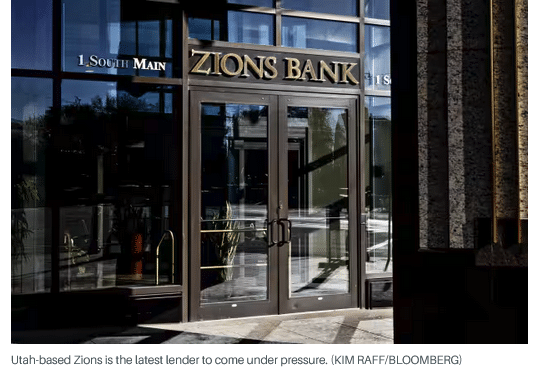
Key Points
- Zions Bancorporation will take a $50 million charge-off in the third quarter due to activity by two commercial and industrial borrowers.
- Zions shares fell 4.8% and the KBW Regional Banking Index dropped 4.8%, its worst one-day decline since April.
- Non-depository financial institutions (NDFIs) now constitute 33% of all commercial and industrial loans from large banks.
New worries about loans by regional banks are sinking stocks as investors fear there’s a bumpy road ahead for credit markets. It comes after the bankruptcies of two auto-industry companies last month turned up the pressure on the banking industry.
The CEO of the biggest U.S. bank, JPMorgan’s Jamie Dimon, raised the issue of those bankruptcies—of subprime auto lender Tricolor Holdings and auto parts maker First Brands—this week, referring to credit market risk when he made the comment “when you see one cockroach, there’s probably more.”
In addition, International Monetary Fund managing director Kristalina Georgieva expressed concern during the IMF/World Bank meetings in Washington, D.C., on Thursday.
More banks are unearthing issues. After the market close on Wednesday, Zions Bancorporation
said it recently became aware of “legal actions initiated by several banks and other lenders” against parties affiliated with two of its commercial and industrial borrowers, with the loans also having guarantees from other individuals.
The upshot is that it will take a $50 million charge-off in its third quarter as part of a $60 million provision related to the loans. Zions shares are falling, and some are speculating that Tricolor and First Brands are the unnamed borrowers.
Truist analyst David Smith doesn’t think investors should jump to conclusions however, given that both those bankruptcies are old news, and Zions has filed lawsuits to cover these loans in California, a state without an apparent connection to Tricolor and First Brands (although that latter point could change).
Either way, however “the credit charges are not helpful for Zions (duh) when investors had gotten a bit squeamish in recent quarters about rising classified loans at the bank, even though the increase seemed to have been driven by a technical regulatory rule change as opposed to a big underlying problem,” he writes. “But is it a good thing or a bad thing in credit terms if these loans went bad due to fraud as opposed to the normal course of business? Either way, there have been enough ‘one-offs’ in commercial credits for banks of late that investors are selling first and asking questions later.”
Zions shares were down 4.8% on Thursday. The news was weighing on other regional banks, with the KBW Regional Banking Index down 4.8% and on pace for its worst one-day decline since April 10, according to Dow Jones Market Data. And the worries were weighing on stocks broadly, with the Dow Jones Industrial Average and the S&P 500SPX-0.03% down 0.8%.
Evercore ISI analyst John Pancari notes that Zions classified the loans as a non-depository financial institution (NDFI), meaning he views the “announcement as the latest in a series of recent credit issues related to fraud and/or bankruptcies within the NDFI space — and expect the topic to remain top of mind for investors and to likely fuel added apprehension around bank NDFI exposures.”
Moreover he highlights that companies including PNC Financial Services Group, Wells Fargo, KeyCorp, First Horizon, Regions Financial, Synovus Financial US Bancorp have relatively high NDFI loan concentrations.
Another regional lender, Western Alliance Bancorporation, came under scrutiny for its hefty NDFI loan book, and its stock fell 10%. In a securities filing it reaffirmed its full-year guidance. But it sued a borrower in August, saying Thursday existing collateral should cover the borrower’s obligation. Nonetheless, it “is still poor optics for Western Alliance’s hefty NDFI lending book coming after concerns last week over a loan to a fund holding First Brands receivables,” Smith notes.
Overall, NDFIs now account for some 33% of all commercial and industrial loans originated by large banks. This was brought to investors’ attention in September, when subprime auto lender Tricolor Holdings and auto parts maker First Brands both went belly up.
There is a silver lining in that it doesn’t appear either bankrupt company holds wider implications about the economy.
For Tricolor, some worry that its lower-income consumers may have become unable to keep up with high interest rate payments in droves. “If that was the reason, it could mean that the lower end of the economy is buckling under tariffs, inflation and slower hiring and that could mean subprime loans across industries could be at risk (and anyone who remembers 2008-2009 knows how bad that can go!)” writes Sevens Report President Tom Essaye.
For First Brands, the concern was more that it was reliant on private credit from sources including private equity and hedge funds. If money was so abundant that First Brands and others were focused on chasing it at the expense of sound business practices, more could follow suit and reverberate among Wall Street lenders.
Luckily for the broader economy, Essaye writes that most now believe that’s not the case, but rather bad or potentially fraudulent financing decisions by management, including allegedly using the same collateral to secure multiple loans. Neither company returned a request for comment.
Overall, these may be isolated incidents. Yet taken together, it’s easy to see why more investors are getting nervous.
Read the full article HERE.


